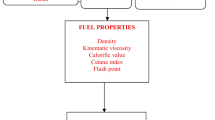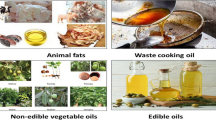Abstract
The effects of using blends of methyl and isopropyl esters of soybean oil with No. 2 diesel fuel were studied at several steady-state operating conditions in a four-cylinder turbocharged diesel engine. Fuel blends that contained 20, 50, and 70% methyl soyate and 20 and 50% isopropyl soyate were tested. Fuel properties, such as cetane number, also were investigated. Both methyl and isopropyl esters provided significant reductions in particulate emissions compared with No. 2 diesel fuel. A blend of 50% methyl ester and 50% No. 2 diesel fuel provided a reduction of 37% in the carbon portion of the particulates and 25% in the total particulates. The 50% blend of isopropyl ester and 50% No. 2 diesel fuel gave a 55% reduction in carbon and a 28% reduction in total particulate emissions. Emissions of carbon monoxide and unburned hydrocarbons also were reduced significantly. Oxides of nitrogen increased by 12%.
Similar content being viewed by others
References
Goering, C.E., A.W. Schwab, M.J. Daugherty, E.H. Pryde and A.J. Heakin, Fuel Properties of Eleven Vegetable Oils,Trans. of the ASAE, 25, 1472–1483 (1982).
Bagby, M.O., B. Freedman, and A.W. Schwab, Seed Oils for Diesel Fuels: Sources and Properties,ASAE Technical Paper No. 87-1583, ASAE, Chicago, 1987, pp. 1–16.
Ryan, T.W., T.J. Callahan, and L.G. Dodge, Characterization of Vegetable Oils for Use as Fuels in Diesel Engines, inVegetable Oil Fuels-Proceedings of the International Conference on Plant and Vegetable Oils as Fuels, Fargo, 1982, American Society of Agricultural Engineers, publication 4-82, ASAE, St. Joseph, MI, Aug. 1982, pp. 70–81.
Tahir, A.R., H.M. Lapp, and L.C. Buchanan, Sunflower Oil as a Fuel for Compression Ignition Engines, in, pp. 82–91.
Fort, E.F., and P.N. Blumberg, Performance and Durability of a Turbocharged Diesel Engine Fueled with Cottonseed Oil Blends, in, pp. 374–382.
Van der Walt, A.N., and F.J.C. Hugo, Attempts to Prevent Injector Coking with Sunflower Oil by Engine Modifications and Fuel Additives, in.
Schlick, M.L., M.A. Hanna, and J.L. Schinstock, Soybean and Sunflower Oil Performances in a Diesel Engine,Trans. of the ASAE, 31: (1988), pp. 1345–1349.
Wagner, L.E., S.J. Clark, and M.D. Schrock, Effects of Soybean Oil Esters on the Performance, Lubricating Oil, and Wear of Diesel Engines, paper No. 841385, Society of Automotive Engineers, Warrendale, 1984, pp. 57–72.
Freedman, B., and E.H. Pryde, Fatty Esters from Vegetable Oils for Use as a Diesel Fuel, inVegetable Oil Fuels-Proceedings of the International Conference on Plant and Vegetable Oils as Fuels, Fargo, 1982, American Society of Agricultural Engineers, publication 4-82, ASAE, St. Joseph, Aug. 1982, pp. 117–122.
Schumacher, L.G., W.G. Hires, and S.C. Borgelt, Fueling a Diesel Engine with Methyl-Ester Soybean Oil, inLiquid Fuels from Renewable Resources, edited by J.S. Cundiff, American Society of Agricultural Engineers, St. Joseph, 1992, pp. 124–131.
Clark, S.J., L. Wagner, M.D. Schrock, and P.G. Piennaar, Methyl and Ethyl Esters as Renewable Fuels for Diesel Engines,J. Am. Oil Chem. Soc. 61:1632–1638 (1984).
Alfuso, S., M. Auriemma, G. Poice, and M.V. Prati, The Effect of Methyl-Ester of Rapeseed Oil on Combustion and Emissions of DI Diesel Engines, Paper No. 932801, Society of Automotive Engineers, Warrendale, 1993, pp. 1–12.
Lee, I., L.A. Johnson, and E.G. Hammond, Use of Branched-Chain Esters to Reduce the Crystallization Temperature of Biodiesel,J. Am. Oil Chem. Soc., 72:1155–1160 (1995).
Freedman, B., M.O. Bagby, J.J. Callahan, and T.W. Ryan, III, Cetane Numbers of Fatty Esters, Fatty Alcohols and Triglyceriders Determined in a Constant Volume Combustion Bomb, paper No. 900343, Society of Automotive Engineers, Warrendale, 1990, pp. 1–9.
Freedman, B., and M.O. Bagby, Predicting Cetane Numbers ofn-Alcohols and Methyl Esters from Their Physical Properties,J. Am. Oil Chem. Soc. 67:565–571 (1990).
Ullman, T.L., R.L. Mason, and D.A. Montalvo, Study of Fuel Cetane Number and Aromatic Content-Effects on Regulated Emissions from A Heavy-Duty Diesel Engine Final Report SWRI 08-2940, Southwest Research Institute, San Antionio, TX, Sept. 1990.
Opris, C.N., L.D. Gratz, S.T. Bagley, K.J. Baumgard, D.G. Leddy, and J.H. Johnson, The Effects of Fuel Sulfur Concentration on Regulated and Unregulated Heavy-Duty Diesel Emissions, paper No. 930730, Society of Automotive Engineers, Warrendale, 1993, pp. 1–19.
Author information
Authors and Affiliations
About this article
Cite this article
Chang, D.Y.Z., Van Gerpen, J.H., Lee, I. et al. Fuel properties and emissions of soybean oil esters as diesel fuel. J Am Oil Chem Soc 73, 1549–1555 (1996). https://doi.org/10.1007/BF02523523
Received:
Accepted:
Issue Date:
DOI: https://doi.org/10.1007/BF02523523




